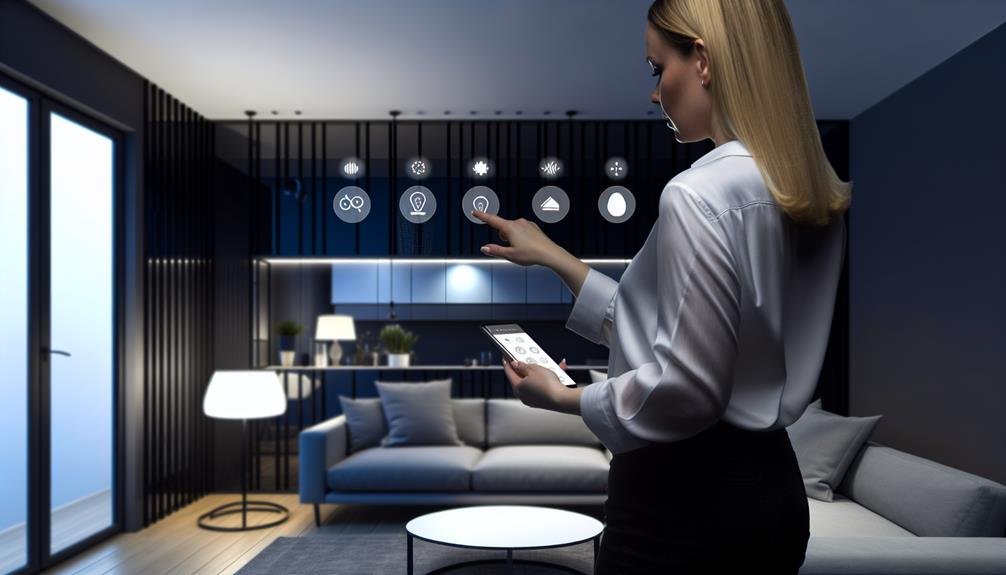Picture this:
You're miles away from home, sitting on a beach with a fruity drink in hand, when suddenly a thought crosses your mind – did you remember to turn off the lights?
With smart home automation, you can put those worries to rest.
Imagine having the power to control your home from anywhere in the world, from the palm of your hand.
But it doesn't stop there.
Smart home automation offers a multitude of benefits that go beyond mere convenience.
So, how exactly does it work?
And what can it do for you?
Get ready to discover a whole new level of control and efficiency that will leave you wanting more.
Key Takeaways
- Integration of voice recognition technology allows for hands-free control of smart home devices.
- Smart home automation can lead to cost savings through potential energy savings and optimization of energy usage.
- Remote access and control of devices through mobile apps and voice control provides convenience and flexibility.
- Enhanced security and safety measures, such as home surveillance and immediate alerts, offer peace of mind for homeowners.
Benefits of Smart Home Automation
There are numerous benefits to implementing smart home automation. One of the key advantages is the integration of voice recognition technology. With this feature, you can control your smart home devices simply by speaking commands, providing you with hands-free convenience and freedom. Whether it's turning on the lights, adjusting the thermostat, or even locking the doors, all it takes is a voice command. This technology not only enhances the user experience but also adds a touch of modernity to your home.
Another benefit of smart home automation is its cost effectiveness. By automating various aspects of your home, you can potentially save money on energy bills. For example, smart thermostats can learn your preferences and adjust temperatures accordingly, optimizing energy usage. Additionally, you can remotely control your home's devices, ensuring they aren't unnecessarily left on when not in use. This level of control allows you to be more mindful of your energy consumption, ultimately leading to potential cost savings over time.
Remote Access and Control of Devices
Access and control your smart home devices remotely with ease and convenience. With the advancements in smart home automation technology, you can now have complete control over your devices from anywhere in the world. Here are some key features that enable remote access and control of your smart home devices:
- Mobile Apps: Most smart home systems come with dedicated mobile apps that allow you to access and control your devices remotely. These apps provide a user-friendly interface to manage your smart home from the palm of your hand.
- Voice Control: Many smart home devices are compatible with voice assistants like Amazon Alexa or Google Assistant. With a simple voice command, you can control your devices remotely, making it even more convenient and hands-free.
- Remote Troubleshooting: In case you encounter any issues with your smart home devices, remote troubleshooting allows you to diagnose and fix problems without being physically present. This saves time and effort, ensuring that your smart home is always up and running smoothly.
- Remote Monitoring: Remote monitoring enables you to keep an eye on your home even when you're away. Whether it's checking security cameras, monitoring energy usage, or adjusting thermostat settings, you can stay connected and in control at all times.
Increased Energy Efficiency
Smart home automation systems offer increased energy efficiency, allowing you to optimize energy usage and reduce your carbon footprint. With energy monitoring capabilities, these systems provide real-time data on your energy consumption, allowing you to make informed decisions about your energy usage. By tracking and analyzing your energy consumption patterns, you can identify areas where energy is being wasted and take steps to rectify it.
One of the key features of smart home automation systems is the ability to create personalized settings for energy usage. You can set schedules for your lights, heating, and cooling systems, ensuring that they're only active when needed. For example, you can program your lights to turn off automatically when you leave the room or set your thermostat to adjust to energy-saving temperatures when you're away from home. These personalized settings not only save energy but also make your home more comfortable and convenient.
In addition to personalized settings, smart home automation systems can also integrate with energy-efficient appliances and devices. By connecting your appliances to the automation system, you can monitor their energy usage and make adjustments as needed. For example, you can receive notifications when your refrigerator's energy consumption is higher than usual, indicating a potential issue that needs attention.
Enhanced Security and Safety Measures
To further enhance the functionality of smart home automation systems, advanced security and safety measures can be integrated seamlessly. With the ability to monitor your home from anywhere, you can have peace of mind knowing that your property is protected at all times.
Here are some key features that enhance the security and safety of your smart home:
- Home Surveillance: Install high-definition cameras throughout your property to keep an eye on any activity. Access the live feed from your smartphone or computer to monitor your home in real-time.
- Motion Sensors: Set up motion sensors that trigger alerts and notifications when any movement is detected. This allows you to take immediate action if any unauthorized entry occurs.
- Door and Window Sensors: Receive alerts whenever a door or window is opened or closed. This helps you stay informed about any potential intrusions and take necessary steps to ensure the safety of your home.
- Emergency Response: Integrate your smart home system with emergency services, allowing you to quickly notify authorities in case of a security breach or any other emergency situation.
With these enhanced security and safety measures, you have the freedom to protect your home and loved ones, even when you're away. Embrace the power of smart home automation and enjoy the peace of mind that comes with it.
Seamless Integration and Compatibility
Seamless integration and compatibility are crucial factors in maximizing the functionality and efficiency of your smart home automation system. One of the key features of a smart home automation system is voice recognition, which allows you to control your devices and appliances using simple voice commands. With voice recognition, you can easily adjust the temperature, turn on/off lights, play music, and even lock/unlock doors, all without lifting a finger.
Another important aspect of seamless integration is smart device compatibility. Your smart home automation system should be able to work seamlessly with a wide range of smart devices, such as smart thermostats, smart lights, smart locks, and smart security cameras. This ensures that you can easily connect and control all your devices from a single interface, eliminating the need for multiple apps and controllers.
To achieve seamless integration and compatibility, it's essential to choose a smart home automation system that supports popular protocols like Wi-Fi, Zigbee, and Z-Wave. These protocols enable communication between different devices and ensure compatibility across various brands and models.





